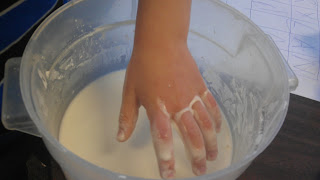Here's a fun sensory filled way to celebrate Dr. Seuss' birthday on March 2nd. Read Bartholomew and the Oobleck and then create some oobleck of your own!
What you'll need:
- water
- cornstarch
- food coloring (optional)
Mix 1 part water with 1.5 to 2 parts cornstarch. Add a few drops of food coloring if you want to make it colored. Stir and stir some more! You will need to stir for about 10 minutes to create oobleck, a weird semi-solid mixture.
Enjoy!
We used the paintbrush to stir the mixture. For the kids who weren't quite ready to touch the oobleck with their hands, they could participate by stirring or just using the paintbrush to touch the oobleck.

















